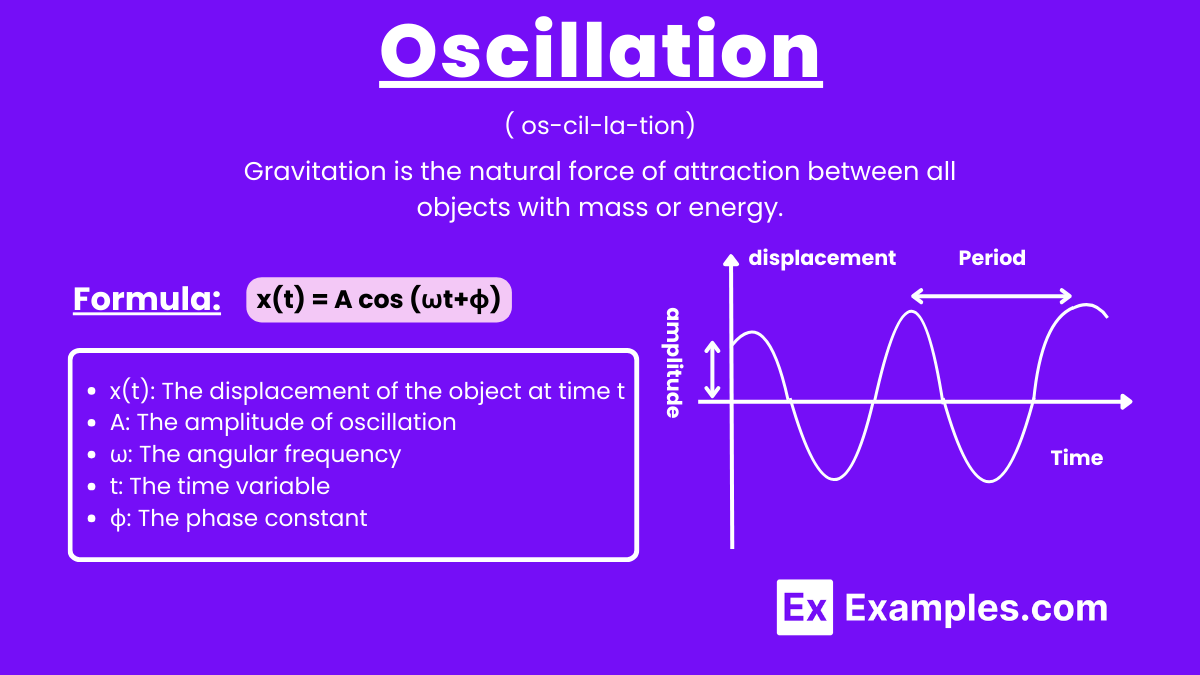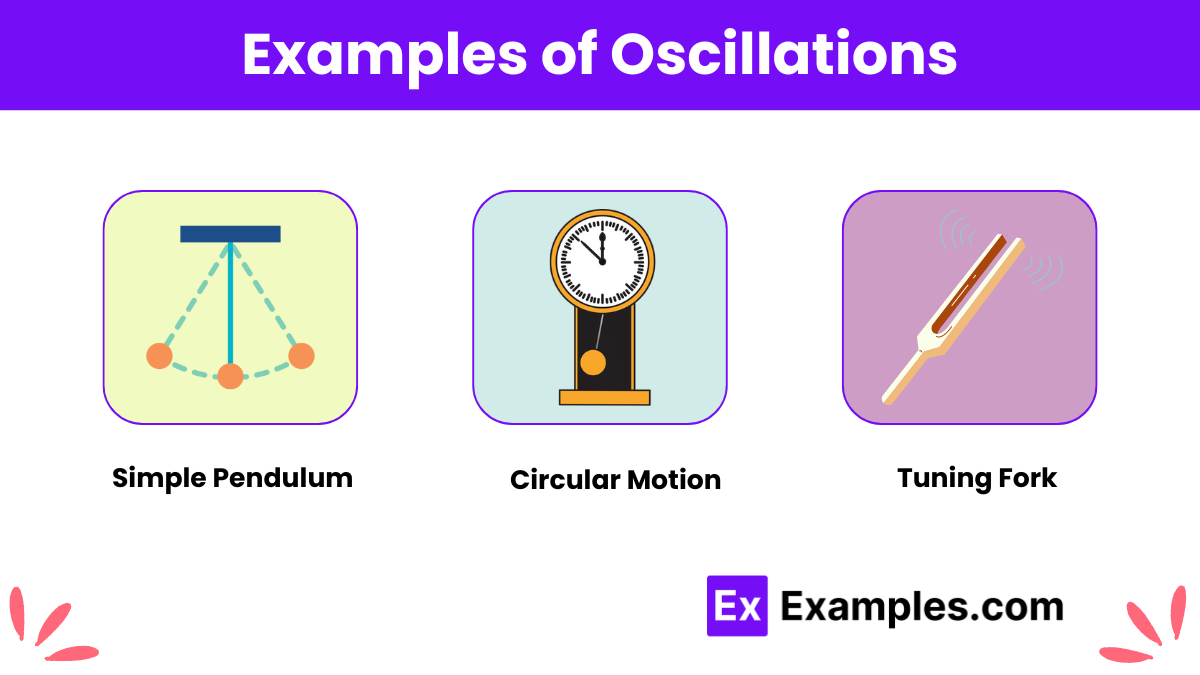What is the term for the time it takes for one complete cycle of oscillation?
Frequency
Wavelength
Period
Amplitude


Oscillation refers to the repeated back-and-forth movement of an object around a central point or equilibrium position. This motion occurs in a regular and periodic manner, where the object moves to and fro in a symmetrical path over time. Oscillations can be seen in various physical systems, such as the swinging of a pendulum, the vibrations of a guitar string, or the alternating current in electrical circuits. The key characteristics of oscillatory motion include its amplitude, frequency, and period, which describe the extent, rate, and duration of the oscillation cycle, respectively. These parameters are often measured in specific units of time, units of vibration, and units of sound to quantify and analyze the motion accurately.
Oscillation in physics refers to the repetitive back-and-forth movement of an object around a central point or between two states. Common examples include a swinging pendulum, vibrating guitar strings, and alternating electrical currents. Oscillations are characterized by amplitude, frequency, and period, and are essential in various physical systems and applications.
In physics, oscillations are often described using mathematical formulas. One of the fundamental equations governing simple harmonic motion (a type of oscillation) is the position function of an oscillating object:
Where:

Oscillations can be classified into several types based on their characteristics and the nature of the system involved. Here are the main types of oscillation:
Free oscillation occurs when a system oscillates naturally without any external force after being initially displaced. The system’s internal forces, such as the restoring force in a spring-mass system, govern the motion. These oscillations have a constant amplitude and frequency, determined by the system’s physical properties.
Examples: A mass attached to a spring and released from a stretched position.
A pendulum swinging in a vacuum.
Damped oscillation occurs when the amplitude of oscillation decreases over time due to the presence of resistive forces, such as friction or air resistance. The system loses energy, causing the motion to gradually cease.
Types of Damping:
Light Damping: The system oscillates with gradually decreasing amplitude.
Critical Damping: The system returns to equilibrium as quickly as possible without oscillating.
Heavy Damping: The system returns to equilibrium slowly without completing a full oscillation.
Example: A swinging pendulum in air gradually comes to rest.
Forced oscillation occurs when an external periodic force drives the system, causing it to oscillate at the frequency of the driving force. If the driving frequency matches the system’s natural frequency, resonance can occur, leading to large amplitude oscillations.
Example: A child being pushed on a swing at regular intervals.
Undamped oscillation refers to ideal oscillations without any energy loss. In this type, the amplitude remains constant over time, and the system oscillates indefinitely. This is a theoretical concept since real-world systems always experience some damping.
Example: A frictionless pendulum in an ideal environment.
Nonlinear oscillation occurs when the restoring force is not directly proportional to the displacement. These systems do not follow Hooke’s Law, resulting in more complex behavior. Nonlinear oscillations can lead to phenomena like chaos.
Example: Large amplitude oscillations of a simple pendulum where the angle is not small.
Linear oscillation occurs when the restoring force is directly proportional to the displacement. These systems obey Hooke’s Law and exhibit simple harmonic motion.
Example: Small amplitude oscillations of a spring-mass system.
Coupled oscillation involves two or more oscillating systems interacting with each other. The energy can be transferred between the systems, leading to complex oscillatory behavior.
Example: Two pendulums connected by a spring.
| Aspect | Oscillation | Vibration |
|---|---|---|
| Definition | Any motion that repeats itself in a regular cycle around a central point or equilibrium position. | Rapid oscillatory motion of an object, often around a fixed point, within a limited range. |
| Examples | Swinging of a pendulum, motion of a spring-mass system, alternating current in electrical circuits. | Vibrating guitar strings, engine vibrations, buzzing of a mobile phone. |
| Frequency | Typically lower frequency. | Generally higher frequency. |
| Amplitude | Can be large or small depending on the system. | Usually smaller amplitude compared to oscillations. |
| Context | Commonly observed in mechanical systems, electrical circuits, and natural phenomena like tides and planetary orbits. | Often associated with mechanical systems, sound waves, and structural analysis. |
| Motion Type | Any periodic motion (e.g., pendulum, spring-mass). | Typically rapid, repetitive motion (e.g., guitar string, engine part). |
The period of oscillation is the time it takes for an object to complete one full cycle of motion.
Frequency is the number of complete oscillations an object makes in one second, measured in Hertz (Hz).
Amplitude is the maximum displacement of an object from its equilibrium position during oscillation.
Damping is the gradual loss of amplitude in an oscillating system due to energy dissipation, often as heat.
Resonance occurs when an oscillating system is driven at its natural frequency, resulting in maximum amplitude.
The restoring force is a force that brings the oscillating object back toward its equilibrium position.
The natural frequency is the frequency at which a system naturally oscillates when not subjected to external forces.
Phase refers to the position of a point in time on the oscillatory cycle, often measured in degrees or radians.
A pendulum is a weight suspended from a pivot that swings back and forth under the influence of gravity, exhibiting oscillatory motion.
Damped oscillations gradually decrease in amplitude due to energy loss, while undamped oscillations maintain constant amplitude.
Text prompt
Add Tone
10 Examples of Public speaking
20 Examples of Gas lighting
What is the term for the time it takes for one complete cycle of oscillation?
Frequency
Wavelength
Period
Amplitude
In a simple harmonic oscillator, what quantity is directly proportional to the restoring force?
Amplitude
Period
Frequency
Displacement
Which type of wave is characterized by oscillations perpendicular to the direction of wave propagation?
Longitudinal wave
Transverse wave
Standing wave
Mechanical wave
What determines the frequency of an oscillating system?
Amplitude
Period
Mass and spring constant (in a spring-mass system)
Energy
What is the effect of increasing the amplitude of an oscillating system on its frequency?
Increases frequency
Decreases frequency
No effect on frequency
Frequency becomes zero
What is the term for the maximum displacement from the equilibrium position in oscillation?
Frequency
Period
Amplitude
Wavelength
In a pendulum, what factors affect the period of oscillation?
Mass of the pendulum bob
Length of the pendulum
Amplitude of swing
Color of the pendulum bob
Which of the following describes a damped oscillation?
Constant amplitude
Increasing amplitude
Decreasing amplitude over time
Constant frequency
What kind of motion does a mass-spring system exhibit if there is no damping?
Simple harmonic motion
Uniform circular motion
Random motion
Linear motion
What is the relationship between frequency (f) and period (T) in oscillatory motion?
f = T²
f = 1/T
T = 1/f
f = T
Before you leave, take our quick quiz to enhance your learning!

